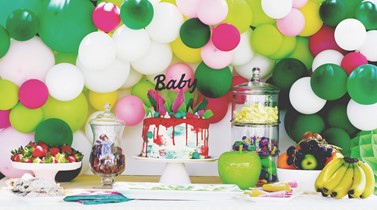Tips for perfect allergy friendly cakes

Sarah Tennant once faced humiliation at the hands of a cake. She lived to tell the tale and share her survival tips with other parents running the gauntlet of allergy-friendly birthday baking.
Here’s a traumatic childhood memory for you. My excellent mother had put us all on soy milk in the hope that it would make us less peculiar (it did not). At kindergarten one day, a parent had brought a birthday cake along to share – straight out of the Australian Women’s Weekly birthday cake book, covered in green coconut to look like a cricket pitch. To my abiding shame, the teacher loudly announced to a gaping class that Sarah Marshall couldn’t have any because she was ‘on a diet’.
A quarter of a century later, of course, she would have said ‘dairy-free’ and a roomful of Jaydens, Braydens and Caydens would have nodded knowingly. Or perhaps there wouldn’t have been a cake at all. Some kindies in NZ have banned them outright. Others require advance notice so they can provide red-food-colouring-free, gluten-free, soy-free, tree-nut-free cupcakes for the afflicted children, lest the stigma and isolation of missing out leave them maladjusted like myself.
Ignoring allergies, alas, is a luxury of the past. Chances are that at some point you will be faced with making a birthday cake for special dietary requirements. Or perhaps your baby’s about to turn one, and after twelve months of lovingly nourishing her with breastmilk and organic pumpkin, you feel odd about polluting her tender innards with gobs of fluorescent blue frosting. Either way, a quick flick through Edmonds isn’t going to cut it.
So what do you do? Force innocent grandparents to ingest a cake-shaped brick of carob and xantham gum? Pay $18 for a bag of organic gluten-free flour you will never use again?
The answer, I reckon – and this is a good principle for allergen-free cooking in general – is to avoid allergen-free versions of normal recipes. A gluten-free, dairy-free pound cake won’t taste as good as the real thing, especially if it was developed by a food blogger who hasn’t tasted the real thing for years and has gradually acclimatised herself to the strange textures of ingredient substitutions. The kid with the allergy might think the cake’s okay, but no one else will.
Instead, use recipes that have stood the test of time on their own two feet before someone noticed: hey, this doesn’t have gluten in it! Think of pavlova, meringues and macarons. They were invented simply to be delicious – not coincidentally, there isn’t a speck of tapioca starch or brown rice flour in any of ‘em. But they’re all gluten-free, soy-free, and (aside from the pav) dairy-free. See what I mean?
Cake for all people
In the case of gluten-free cake, that leaves you with two main options: the dense, dark torte and the cornflour sponge. Tortes are based around eggs, sugar, butter, and sometimes chocolate or ground almonds. The good news is they taste fabulous and sophisticated while being a doddle to make, and are so moist they don’t need icing (though you can if you want). The bad news is they tend to be an inch high at best – no good for sculpting into Thomas the Tank Engine. The chocolate mousse cake recipe I’ve shared HERE is a torte of this sort. It’s fabulous.
If you’re going for the traditional sky-high layered cake, cornflour sponge is your best bet. Some cooks prefer cornflour to wheat flour because of the extra tenderness it gives. It’s no harder than a regular sponge cake, though they’re always a bit knacky; and you can flavour it any way you like by brushing the cooked sponge with a simple syrup made of equal parts sugar and liquid. (Water with a dash of vanilla is fine; fruit juice, coffee or coconut cream are delicious.)
Best of all, the cornflour sponge recipe I’ve also shared HERE is a twofer – dairy-free as well as gluten-free.
In fact, dairy-free cakes are easy. Oil makes a moister cake than butter does, but butter is more flavoursome; so cake recipes with strong flavours, such as lemon, carrot and banana, often use oil. Any milk or yoghurt in the recipe can easily be substituted with a nut milk and coconut yoghurt. (I would, incidentally, avoid ‘Crazy Cake’, a Depression-era milkless, eggless, butterless, tasteless cake that crops up on dairy-free forums. There’s a reason it disappeared when the economy recovered, people: you can do better.)
The icing on the cake
When it comes to frosting, the boot’s on the other foot: gluten-free is easy, dairy-free is a pain. The only time gluten is likely to show up in frosting is if your icing sugar contains cornflour made from wheat instead of, well, corn. Why this ingredient exists at all, I do not know: but check the package and you’ll be fine.
The easiest form of dairy-free icing is a glaze: icing sugar mixed with water, fruit juice or coffee to a thin consistency. It can taste good – a thin lemon glaze on a banana cake is lovely – but it doesn’t exactly scream ‘birthday cake’.
For that, you want something with a bit of fluff to it. Swiss meringue is made by whisking egg whites and sugar together over a double boiler until dissolved, then cooling the now-pasteurised mixture and beating until stiff. Unlike regular (French) meringue, it can’t be gritty, and it won’t weep or leak. It also lends itself well to flavouring – you can beat in anything from berry pureé to lime zest or melted dark chocolate.
Another option is coconut cream frosting. This is less versatile as it tastes definitely (though not unpleasantly) coconutty, but it’s worth mentioning because it’s so darn cool. To make it, you put a can of coconut cream in the fridge upside-down for a few hours. I use Pam’s, which doesn’t contain emulsifiers – you want the firm coconut cream to separate from the watery stuff. When that happens, simply pour off the water, use electric beaters to fluff up the cream, and add whatever flavourings you like. A touch of sugar and vanilla is lovely; melted dark chocolate will make a mousse-like substance you can use for piping.
Coconut cream frosting and regular whipped cream are also good options if you’re trying not to use too much sugar. They only need a touch of sweetener to be sumptuous, and if you’re feeling really virtuous, you can even use honey or maple syrup instead.
Rainbow unicorns
Avoiding artificial food colourings? There are a lot of ways to do this, and the laziest is to avoid the issue entirely by steering your children toward cakes decorated like drab, brownish marsupials. Chocolate icing tastes good and I have yet to meet anyone allergic to cocoa.
Ah, but your little darling insists on a My Little Pony cake? Of course she does, the stinker. Well, it’s doable ... more or less.
With natural food colourings, it’s a case of “cheap, easy, tasty: pick two”. The easy and tasty version, and my favourite option by far, is NZ’s own ‘Fresh As’ freeze-dried fruit and berry powders. They come in a wide variety of flavours, from mango to blueberry, and will give you most of the warm-colour spectrum in subtle to vibrant shades. They are, however, around $11 for a small packet.
If you’re dedicated and have a dehydrator, you can make your own powdered berries and fruits. A quicker way is to juice or mash the fruits and boil the juice down into a concentrate. Dark berries will give you a lovely purple; red berries pink; and carrot juice, which is fortunately sweetish, a yellow-orange.
Cool colours are harder, for the simple reason that you don’t want your frosting tasting like parsley or spirulina. You can get away with adding a small amount of green vegetable juice, but it’s risky. Matcha (green tea powder) gives a nice pale green shade along with a flavour somewhat more socially acceptable, at least to adults.
As for blue, that’s tricky. Blue tends to fade to purple over time, especially in the presence of sunlight or acid. Food bloggers have experimented with adding a touch of baking soda to a purple juice made from boiling red cabbage; it makes a nice pale blue, but turns back to purple if mixed into an acidic frosting (like cream cheese), and as you can imagine, adding too much baking soda gives the frosting an unpleasant taste. Moral of the story: avoid blue.
Black, on the other hand, can be made quite easily: but only if you’re willing to hunt down black cocoa, activated charcoal or ... wait for it ... squid ink. This is available at Mediterranean grocers, as it’s used to dye pasta black. Be sure to smile brightly at your guests as you say “Enjoy your cake – you don’t have any allergies to shellfish, I hope?”.
If you only need small areas of black, try using pieces of liquorice or pulverised Oreos. To minimise the taste of charcoal/mollusc, use regular cocoa to make your frosting as dark as possible, then just a dash of black colouring to take it the rest of the way. It all sounds a bit more mad scientist than Martha Stewart, and it’s definitely not as easy as grabbing a Wendy’s ice cream cake; but making a cake everyone at the party can enjoy can really make a kid’s – and parent’s – day. And given that you made them leave the house at ten on a Saturday to come watch your kid open presents, it’s the least you can do.
|
Supermarket success Marshmallows, depending on the brand, can be gluten- and dairy-free. Whittakers’ plain types of dark chocolate are dairy-free, as are some of the filled types (check the label). Signature Brand candy sprinkles are gluten-free; so are original and peanut M&Ms, Reese’s Pieces and Bounty bars. If you don’t have the time or panache to decorate, chopped-up candy bars and sweets piled high on a cake are always popular! That said, always check the labels – ingredients change from time to time. |
Sarah Tennant bakes birthday cakes in Te Awamutu for a husband, three children and assorted friends and relations with a dizzying range of dietary foibles.

AS FEATURED IN ISSUE 40 OF OHbaby! MAGAZINE. CHECK OUT OTHER ARTICLES IN THIS ISSUE BELOW

















